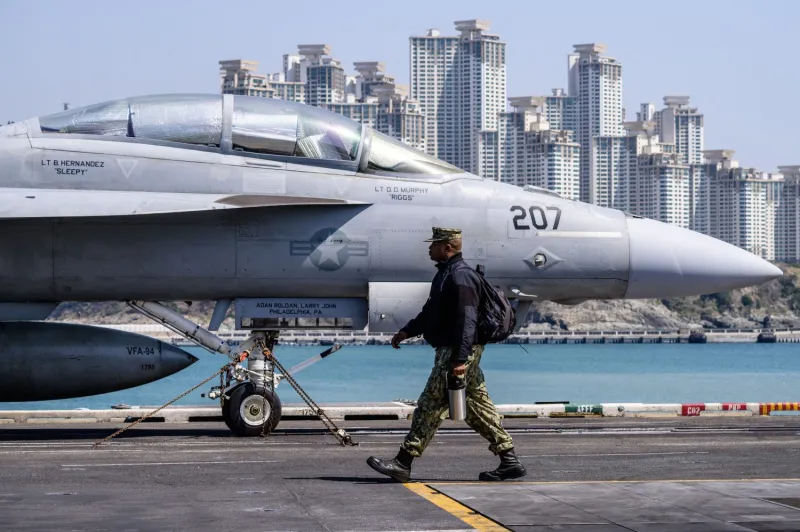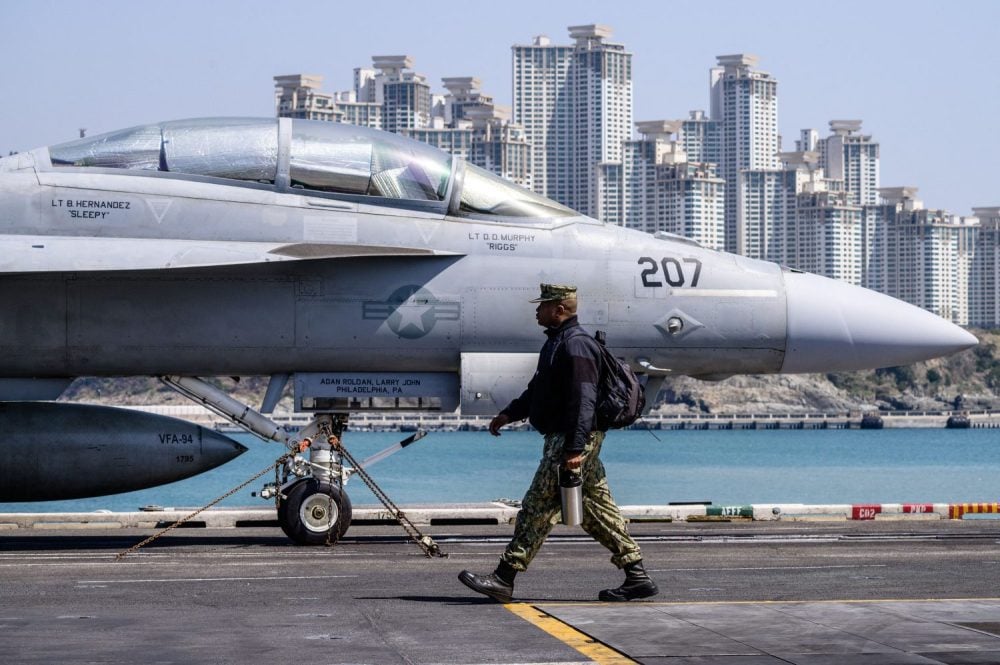beijingwalker
ELITE MEMBER

- Joined
- Nov 4, 2011
- Messages
- 65,191
- Reaction score
- -55
- Country
- Location
U.S. Military Deterrence Against China Is Not Working
With U.S. military superiority in Asia no longer a given, defense planners need a different strategy.
By Bryan Clark, the director of the Center for Defense Concepts and Technology at the Hudson Institute, and Dan Patt, a senior fellow at the Hudson Institute.
A U.S. Navy sailor walks past an F/A-18F fighter jet on the flight deck of the USS Nimitz aircraft carrier in the port of Busan, South Korea, on March 28.
SEPTEMBER 5, 2023, 7:00 AM
For more than three decades, the U.S. military’s global preeminence has been the rock on which U.S. strategy and security policy are built. But technology diffusion, growing global challenges, and antiquated force design have eroded the United States’ military edge against China, which could exploit its geographical proximity and advancing capabilities to win a regional war against Taiwan. Without the certainty of continued military dominance that, until now, gave Washington the ability to simply deny and suppress aggression in East Asia, U.S. leaders seeking conventional deterrence will need to devise a different strategy.
Despite the rhetoric in parts of Washington, war with China is not imminent, and an invasion of Taiwan carries many risks for the Chinese Communist Party as it faces mounting economic, demographic, and diplomatic challenges. To make an invasion unattractive for Beijing, the U.S. military may merely need to raise China’s perception that any conflict would be drawn out and exceedingly costly. Instead of optimizing the U.S. military for an invasion that may never come, Washington should therefore mount a long-term campaign that undermines Beijing’s confidence in a range of violent paths to realizing its ambitions in Taiwan and the region. This campaign should involve military and nonmilitary means that seek to steer China toward more responsible and peaceful paths to its foreign-policy goals.
Proponents of an unchanged strategy of deterrence through denial argue the best way to deter Beijing is to make an invasion of Taiwan infeasible by massing sufficient strike capability in the region to convince Chinese President Xi Jinping that an attack would fail. With China now operating the world’s largest navy, army, rocket force, civilian fleet, and industrial base (which builds new ships and missiles at more than twice the U.S. pace), this plan has become simply unrealistic over the long term. Furthermore, some scenarios—such as a Chinese blockade, quarantine, or operation against Taiwan’s smaller islands—may prove impossible to completely deny.
What denial really means under these new conditions, then, is to create uncertainty in the minds of Chinese leaders that their plans could succeed on terms acceptable to Beijing. An invasion that bogs down and drains resources like Russia’s war in Ukraine or sinks China’s faltering economy could quickly lose support, and any victory would be pyrrhic. However, U.S. defense planning and decision-making still focus on whether an operation succeeds or a system works on an East Asian battlefield—not whether the result is sufficient to make Xi and other Chinese leaders think twice about aggression as they consider launching it.
To gain that understanding and restore the role of strategy in defense planning, the U.S. Defense Department should begin by following its own directives. One of the 2022 National Defense Strategy’s main components is the notion of campaigning, which in military doctrine describes an orchestrated series of military and nonmilitary actions designed to achieve specific objectives. But in Pentagon practice, the campaigning element of U.S. strategy has become little more than a bucket for various budget items related to military readiness that don’t easily fall under the defense strategy’s other headings.
A more promising strategy would focus on lowering Xi’s preference for aggression in the first place, making other paths more attractive.
Rather than using campaigning as a budget justification for a motley collection of training programs, maintenance, deployments, and exercises, the Defense Department should take its own definition of campaigning seriously—and build a strategy to reveal and eventually shape the perceptions of Chinese leaders.
China is already engaged in its own campaign, exemplified by sustained air and maritime intrusions into Taiwan’s airspace and waters, as well as invasion rehearsals featured on WeChat. The numbers of troops, ships, aircraft, missiles, and vehicles involved fall far short of what would be needed to subdue an island of 23 million people, but the operations are not intended to test either the Chinese People’s Liberation Army (PLA) or Taiwanese forces. Instead, these events are part of a campaign to shape perceptions at home and abroad.
This is not to say the Defense Department has been idle in its broader effort to shape Chinese decision-making. In the last two years, the establishment of the Australia-United Kingdom-United States (AUKUS) security pact, expanded military cooperation with the Philippines and Japan, and continued support for Ukraine have all undoubtedly eroded Chinese leaders’ confidence.
As we recently outlined in a Hudson Institute report, a proper strategy of campaigning would build on these initiatives. Big moves like AUKUS cannot be repeated at will or be timed to best effect, which reduces their utility as a signal. But small military actions, such as new force compositions, capabilities, tactics, postures, and allied operations, can elicit diverse and frequent signals from the way China responds; test hypotheses regarding areas of Chinese concern or confidence; and provide opportunities to shift Beijing’s beliefs.
During the Cold War, U.S. national security leaders practiced a similar approach to expose and exploit Soviet neuralgia regarding issues such as homeland missile defense and submarine vulnerability. Today, new information technologies, from open-source satellite imagery to algorithmic analysis, can empower and accelerate the process. Instead of the traditional use of technology to serve an operational plan, it would be used to build and orchestrate the campaign plan.

U.S. Deterrence Against China Is Not Working
With U.S. military superiority in Asia no longer a given, defense planners need a different strategy.


